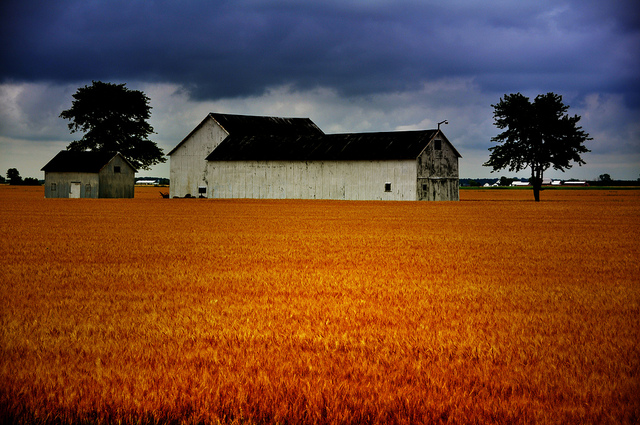Like this article? rabble is reader-supported journalism. Chip in to keep stories like these coming.
This guest post, by Kelly Hodgins, originally appeared in the Guelph Mercury. Kelly is the program co-ordinator for Feeding 9 Billion at the University of Guelph. She and her colleagues are hosting an Eat Think Vote event to discuss these issues with Guelph’s electoral candidates this Saturday (Sept. 19) from 12:30-3 p.m. at Innovation Guelph. All are welcome.
I recently received a set of old photos of my parents’ British Columbia farm from a woman who grew up there in the 1950s.
Each was accompanied by beautiful descriptions: the apple tree that fed a family of nine; the pigs that prepared garden beds; the butcher shed my father ran to serve local farmers; the kids’ chores feeding cattle. The captions spoke of a time when food production, processing and consumption were integrated into our homes, lives and community.
Today, our food system is undeniably disjointed. Approaching the 2015 federal election, I can’t help but reflect on these issues and how they impact all Canadians — rural, urban, Northern, immigrant, adult and child.
Four in particular deserve attention on the 2015 election agenda. These have been identified by Food Secure Canada as the most necessary first steps to a more healthy, equitable and just Canadian food system.
First, we must understand that food has been commodified. Food production has vacated our backyards and has been assigned to an ever-shrinking, aging group of farmers. Food security is compromised when the majority of Canadians rely on purchasing food instead of growing or sharing it. This has serious implications for those who cannot afford adequate, nutritious diets. Four million Canadians are food-insecure today — a figure that is unacceptable in a developed, wealthy nation. Food insecurity is a symptom of poverty, and poverty is a problem of politics. Food Secure Canada is calling on a feasibility study into a basic income floor, to lift the most vulnerable Canadians out of poverty, thereby improving diets, stimulating demand for nutritious food, and lowering health-care burdens.
Second, we must pay serious attention to our children, specifically through a national student food program. The frolicking children in these old farm photos had an innate connection with food, and they were (like it or not) involved with its production. Today, my parents host school tours, in which a fraction of the students have ever set foot on a farm, and an astounding majority admit knowing little about cooking. A school food program will improve food literacy, as well as help address the deplorable rate of food insecurity noted above. As the only G8 country that doesn’t provide healthy meals for its kids, we are failing to support our young people’s well-being, as well as their learning capacity.
At the opposite end of the age spectrum, Canada faces an unprecedented farmer-succession crisis. The average age of producers is 55, and there is marginal incentive for any young person to take over. Policy is critically needed to make agriculture a more attractive and viable profession for the next generation of farmers — policy that allows energetic young agrarians like myself to realistically consider moving from talking about food to actually producing it, or that allows new immigrants with invaluable agricultural expertise access to land and capital.
At the same time, those of us trying to create a sustainable food system are facing greater threats every year. The water tower featured in the old farm photos is now replaced with a well — digging deeper for water as summer rains become more sporadic.
But Western Canada’s dry summers (typified by the devastating 2015 drought) are not the only climatic shift affecting our food system. Climate change is intersecting negatively with food-security most dramatically in Canada’s North. There, food-gathering traditions are being upturned due to changing migration patterns and weather systems.
Each year, vulnerable northern Canadian communities are made more reliant on imported food. We urgently need politically mandated action that takes direction from those most affected to rectify the astonishingly high food prices and skyrocketing rates of diet-related diseases, which is set to only worsen as centuries-long traditions are erased through irreversible ecosystem change in Canada’s North.
The woman who sent me these old photos of our farm ended her note by saying: “After mother sold the farm, I stopped driving by. The buildings were gone, the fences down, and fields empty. A few years ago, I cautiously decided to come to take another look. My heart soared to see the farm up and running again. Thank you for returning my childhood home back into the land it was intended for.”
I call upon the next governing party in Ottawa to similarly revitalize our Canadian food system.
We cannot afford to see a nation of empty fields and collapsed fences while remaining complacent with four million hungry bellies. We must stimulate our national food system into a healthy and just one: a food system that supports livelihood-insecure producers and food-insecure consumers in tandem.
Photo: oliver gartmann/flickr
Like this article? rabble is reader-supported journalism. Chip in to keep stories like these coming.




